April 25, 2023 feature
This article has been reviewed according to Science X's editorial process and policies. Editors have highlighted the following attributes while ensuring the content's credibility:
fact-checked
peer-reviewed publication
trusted source
proofread
The dynamics of 'hotspot forming' high-energy quasiparticles in a superconducting nanowire
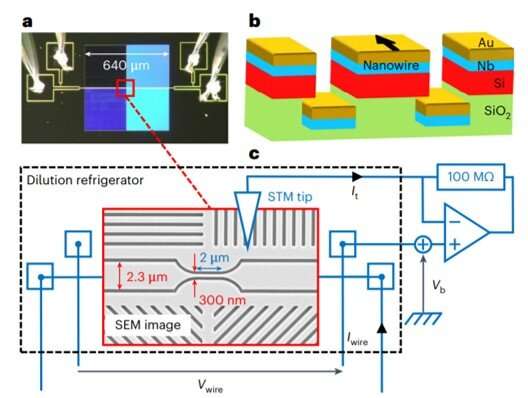
Energetic quasiparticles possess a collection of quantum characteristics that operate in a particle-like way in superconducting nanostructures, and they can undergo relaxation by involving many cascaded interactions between electrons, phonons and Cooper pairs. These interactions are significant to the performance of devices such as qubits or photon detectors, yet they remain to be well understood via quasiparticle regulated experiments. Typically, such experiments have incorporated solid-state tunnel junctions with a fixed tunnel barrier.
In a new report in Nature Physics, T. Jalabert and a team of researchers in France used a scanning tunneling microscope to independently tune the energy and rate of quasiparticle injections via the bias voltage and tunneling current. The high energy quasiparticles relied on the injected power and injection rate to yield a reduced critical current on the nanowire. The outcomes highlighted a thermal mechanism underlying the reduction of the critical current to provide insights into the rapid dynamics of a generated hot spot.
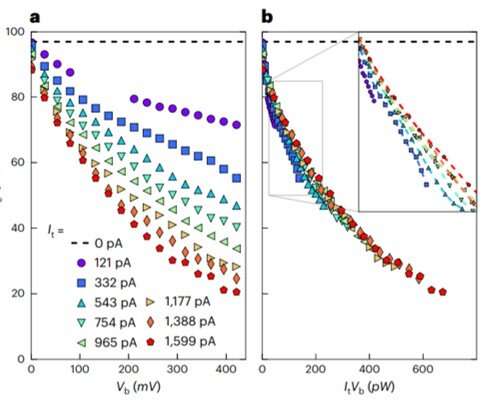
The performance of superconducting devices
Superconducting devices are often limited or governed by quasiparticle dynamics, where excess quasiparticles are not beneficial for devices such as superconducting micro-coolers and superconducting qubits. However, knowing the precise mechanism underlying quasiparticle dynamics is important in order to optimize device performance and provide a pre-requisite to operate photon detectors. Despite intense research efforts, physicists remain to understand the processes at risk during the energy relaxation of quasiparticles in current carrying superconductors.
In a recent proposal, experimental physicists had developed an all-metal Josephson field-effect transistor, which relied on regulating its critical current after applying a gate voltage. This gave rise to considerable controversy since it suggested a heating-effect after injecting high-energy quasiparticles. Previous experiments also routinely employed a method; however, it prevented the disentanglement between current and voltage effects, which Jalabert and colleagues overcame by using a scanning tunneling microscope (STM) to locally inject quasiparticles into a super-conducting nanowire and simultaneously measure its critical current.
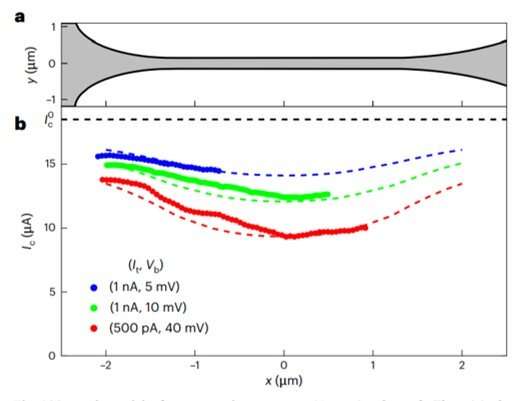
Experimental physics with scanning tunneling microscopy (STM)
The process of locating and contacting an individual nanostructure with a scanning tunneling microscope is challenging due to the intrinsic incompatibility of the microscope to isolate a nanostructure. Physicists and materials scientists had previously focused on combining atomic force microscopy and STM, although both methods are technically tedious. In this study, Jalabert and the team used STM to locate and measure the nanodevice and studied six superconducting nanowires with different niobium/gold nominal total thickness.
They measured the critical current after injecting quasiparticles in the middle of the nanowire, and noted how the critical current depended on the injected power. In a thermodynamic framework, each quasiparticle injected into the setup relaxed its energy to phonons, which thereby broke hundreds of Cooper pairs to generate many out-of-equilibrium quasiparticles that formed the so-called hotspot. This down-conversion cascade occurred in a very short time-frame in the order of picoseconds.
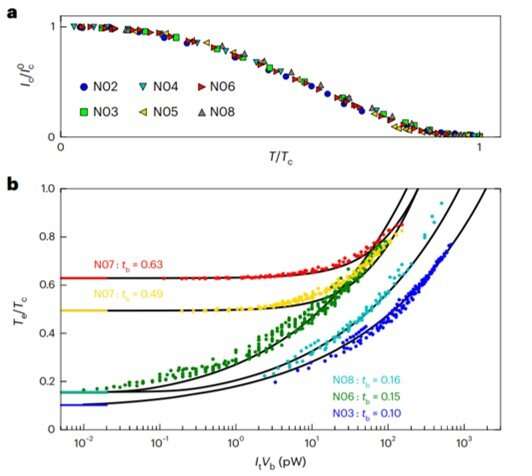
Hotspot dynamics
Using scanning tunneling microscopy, Jalabert and colleagues mapped the current as a function of the tip position for fixed tunneling conditions. As the position of the tip moved away from the leads or as the injected power increased, the critical current decreased further. The physicists determined the local electronic temperature from the measured critical current and noted a remarkable agreement between the one-dimensional heat model. All experimental data were in support of a hot quasiparticle-induced thermally driven reduction of the critical current. They showed how an excess of quasiparticles in the hotspot reduced the density of Cooper pairs available to carry the superfluid current, which agreed with previous studies.
The hotspot dynamics relied on the balance between the proliferating quasiparticles in the down-conversion cascade and their escape through diffusion. In the models described herein, only the growing number of out-of-equilibrium quasiparticles mattered. The time of hotspot formation was 40 picoseconds, which matched the time required for quasiparticle diffusion across the width of the nanowire. The team intend to conduct further studies to solve the coupled kinetic equations of interacting quasiparticles and phonons; beyond the scope of the present work.
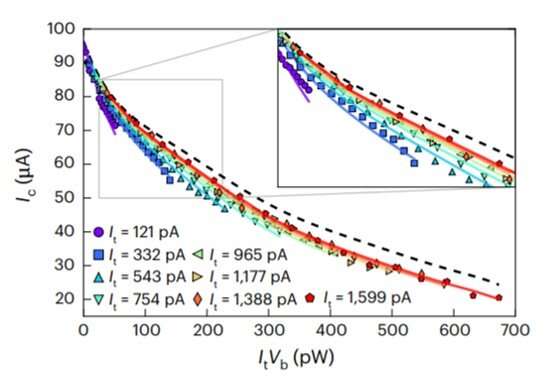
Outlook
In this way, T. Jalabert and colleagues formed a powerful new method to study the dynamics of local quasiparticles in superconducting nanostructures to tune the tunneling rate and quasiparticle energy. The physicists used the experimental setup to show how the critical current of a nanowire could be significantly reduced by injecting a quasiparticle injection current of several magnitudes lower.
They credited the outcome to the phenomenon of thermal heating of quasiparticles; the results have an immediate impact on the function of superconducting nanodevices such as field-effect transistors and photon detectors, with added capacity to design superconducting quantum circuits with improved effects of quasiparticles in the future.
More information: T. Jalabert et al, Thermalization and dynamics of high-energy quasiparticles in a superconducting nanowire, Nature Physics (2023). DOI: 10.1038/s41567-023-01999-4
Journal information: Nature Physics
© 2023 Science X Network




















